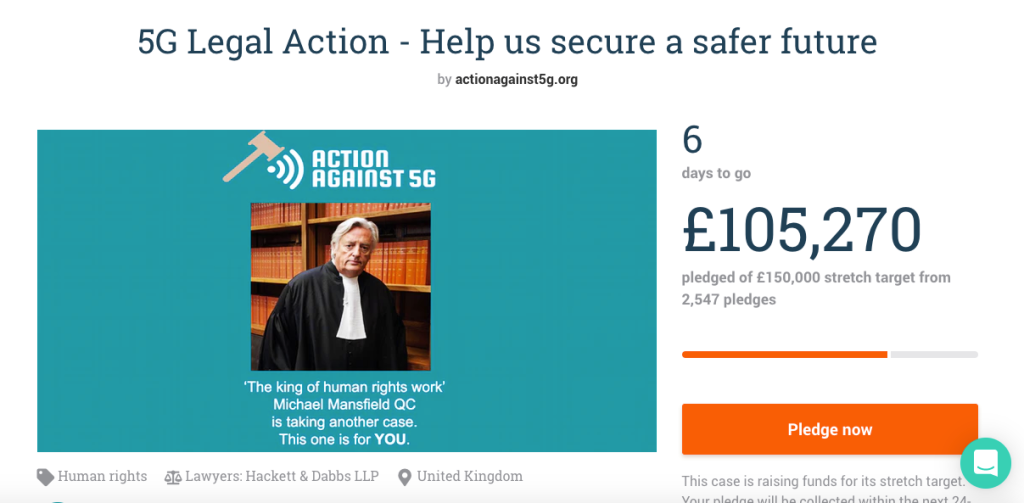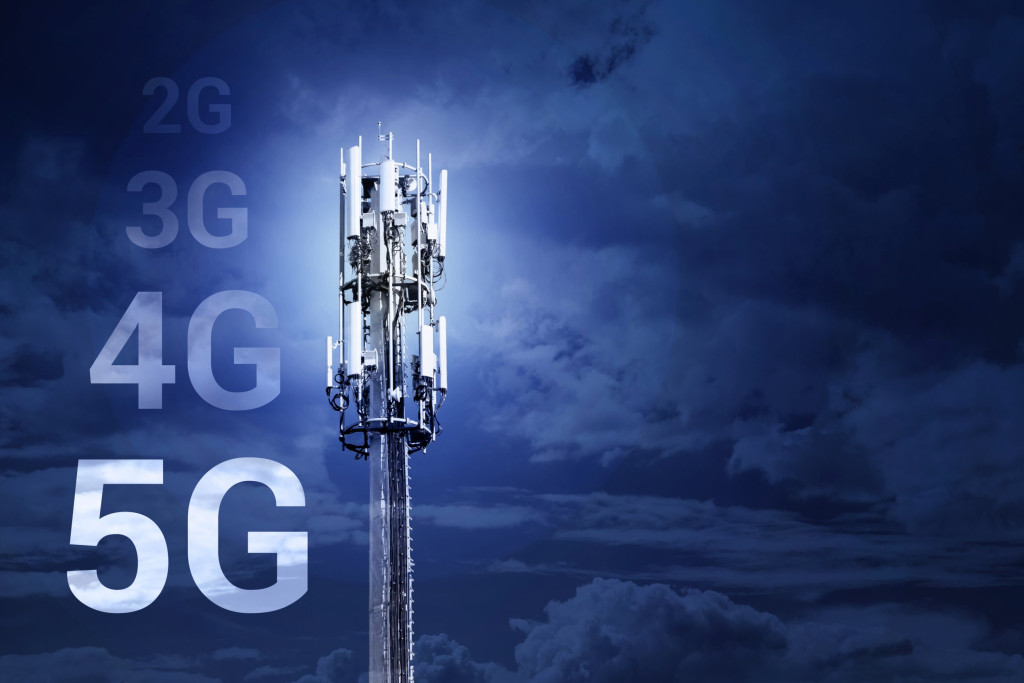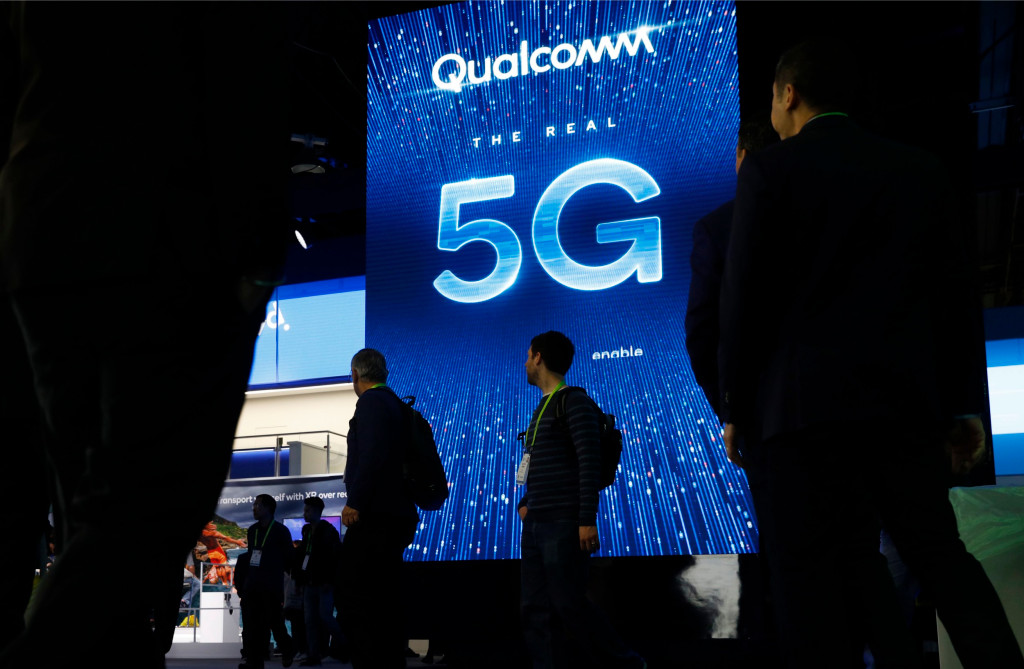Technology
The field of natural language processing is chasing the wrong goal
At a typical annual meeting of the Association for Computational Linguistics (ACL), the program is a parade of titles like “A Structured Variational Autoencoder for Contextual Morphological Inflection.” The same technical flavor permeates the papers, the research talks, and many hallway chats.
At this year’s conference in July, though, something felt different—and it wasn’t just the virtual format. Attendees’ conversations were unusually introspective about the core methods and objectives of natural-language processing (NLP), the branch of AI focused on creating systems that analyze or generate human language. Papers in this year’s new “Theme” track asked questions like: Are current methods really enough to achieve the field’s ultimate goals? What even are those goals?
My colleagues and I at Elemental Cognition, an AI research firm based in Connecticut and New York, see the angst as justified. In fact, we believe that the field needs a transformation, not just in system design, but in a less glamorous area: evaluation.
The current NLP zeitgeist arose from half a decade of steady improvements under the standard evaluation paradigm. Systems’ ability to comprehend has generally been measured on benchmark data sets consisting of thousands of questions, each accompanied by passages containing the answer. When deep neural networks swept the field in the mid-2010s, they brought a quantum leap in performance. Subsequent rounds of work kept inching scores ever closer to 100% (or at least to parity with humans).
So researchers would publish new data sets of even trickier questions, only to see even bigger neural networks quickly post impressive scores. Much of today’s reading comprehension research entails carefully tweaking models to eke out a few more percentage points on the latest data sets. “State of the art” has practically become a proper noun: “We beat SOTA on SQuAD by 2.4 points!”
But many people in the field are growing weary of such leaderboard-chasing. What has the world really gained if a massive neural network achieves SOTA on some benchmark by a point or two? It’s not as though anyone cares about answering these questions for their own sake; winning the leaderboard is an academic exercise that may not make real-world tools any better. Indeed, many apparent improvements emerge not from general comprehension abilities, but from models’ extraordinary skill at exploiting spurious patterns in the data. Do recent “advances” really translate into helping people solve problems?
Such doubts are more than abstract fretting; whether systems are truly proficient at language comprehension has real stakes for society. Of course, “comprehension” entails a broad collection of skills. For simpler applications—such as retrieving Wikipedia factoids or assessing the sentiment in product reviews—modern methods do pretty well. But when people imagine computers that comprehend language, they envision far more sophisticated behaviors: legal tools that help people analyze their predicaments; research assistants that synthesize information from across the web; robots or game characters that carry out detailed instructions.
Today’s models are nowhere close to achieving that level of comprehension—and it’s not clear that yet another SOTA paper will bring the field any closer.
How did the NLP community end up with such a gap between on-paper evaluations and real-world ability? In an ACL position paper, my colleagues and I argue that in the quest to reach difficult benchmarks, evaluations have lost sight of the real targets: those sophisticated downstream applications. To borrow a line from the paper, the NLP researchers have been training to become professional sprinters by “glancing around the gym and adopting any exercises that look hard.”
To bring evaluations more in line with the targets, it helps to consider what holds today’s systems back.
A human reading a passage will build a detailed representation of entities, locations, events, and their relationships—a “mental model” of the world described in the text. The reader can then fill in missing details in the model, extrapolate a scene forward or backward, or even hypothesize about counterfactual alternatives.
This sort of modeling and reasoning is precisely what automated research assistants or game characters must do—and it’s conspicuously missing from today’s systems. An NLP researcher can usually stump a state-of-the-art reading comprehension system within a few tries. One reliable technique is to probe the system’s model of the world, which can leave even the much-ballyhooed GPT-3 babbling about cycloptic blades of grass.
Imbuing automated readers with world models will require major innovations in system design, as discussed in several Theme-track submissions. But our argument is more basic: however systems are implemented, if they need to have faithful world models, then evaluations should systematically test whether they have faithful world models.
Stated so baldly, that may sound obvious, but it’s rarely done. Research groups like the Allen Institute for AI have proposed other ways to harden the evaluations, such as targeting diverse linguistic structures, asking questions that rely on multiple reasoning steps, or even just aggregating many benchmarks. Other researchers, such as Yejin Choi’s group at the University of Washington, have focused on testing common sense, which pulls in aspects of a world model. Such efforts are helpful, but they generally still focus on compiling questions that today’s systems struggle to answer.
We’re proposing a more fundamental shift: to construct more meaningful evaluations, NLP researchers should start by thoroughly specifying what a system’s world model should contain to be useful for downstream applications. We call such an account a “template of understanding.”
One particularly promising testbed for this approach is fictional stories. Original stories are information-rich, un-Googleable, and central to many applications, making them an ideal test of reading comprehension skills. Drawing on cognitive science literature about human readers, our CEO David Ferrucci has proposed a four-part template for testing an AI system’s ability to understand stories.
- Spatial: Where is everything located and how is it positioned throughout the story?
- Temporal: What events occur and when?
- Causal: How do events lead mechanistically to other events?
- Motivational: Why do the characters decide to take the actions they take?
By systematically asking these questions about all the entities and events in a story, NLP researchers can score systems’ comprehension in a principled way, probing for the world models that systems actually need.
It’s heartening to see the NLP community reflect on what’s missing from today’s technologies. We hope this thinking will lead to substantial investment not just in new algorithms, but in new and more rigorous ways of measuring machines’ comprehension. Such work may not make as many headlines, but we suspect that investment in this area will push the field forward at least as much as the next gargantuan model.
Jesse Dunietz is a researcher at Elemental Cognition, where he works on developing rigorous evaluations for reading comprehension systems. He is also an educational designer for MIT’s Communication Lab and a science writer.
Technology
How To Transfer Contacts From Android To iPhone In Real-Time?
If you were to transfer contacts from Android to iPhone, it was quite a task a few years ago. But we are living in 2020 now, and both Apple and Google have made efforts to improve the cross-platform compatibility between their operating systems.
Speaking of which, you can easily sync contacts when switching to a new iPhone, that too in real-time. It goes without saying that these methods will work for iPad also, even though it now runs iPadOS.
Also Read: How To Enable ‘Water Running’ Notification On iOS 14?
How to transfer contacts from Android to iPhone in real-time?
This method to sync contacts is quite popular and might be helpful for new iOS users who don’t want much hassle. You don’t need to go through the pain of downloading some file and uploading it to your iCloud account; all the stuff happens in the blink of an eye.
You can follow the steps mentioned below to import contacts to iPhone automatically:
- On your iPhone, open the Settings app.
- Scroll down, and go to Passwords and Accounts.
- Next, tap on Add Account and choose Google on the next screen.

- Click on Continue when the prompt appears.

- After that fill in your Gmail account details in the browser pop-up.
- Next, choose the stuff you want to sync from your Gmail account.
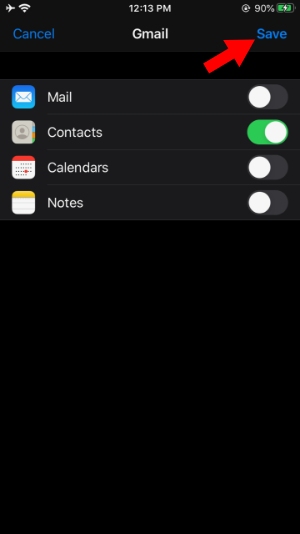
- Tap on Save option in the top-right corner.
Once you finish the setup, the contacts from your Gmail account will start showing up in your iPhone contact list. Also, there are other data like notes and calendars that you can transfer from Android to iPhone.
Testing Android to iPhone real-time Google sync

One important thing to note is that these contacts are still in your Google account. Here, you can go to Settings > Contacts > Default Account > Select Gmail as default. Now, all the new contacts saved on the device will be added to your Google account.
If iCloud is the default option, then you’ll end up creating a mess, so it’s better to keep all the contacts in one place.
Now, here comes the best part. From now on, you don’t need to make efforts to sync Android contacts to iPhone in the future.
To test whether the real-time sync works without any issues or not, when I create a new contact on my Android device (Google Contacts), it appears on my iPhone in no time.
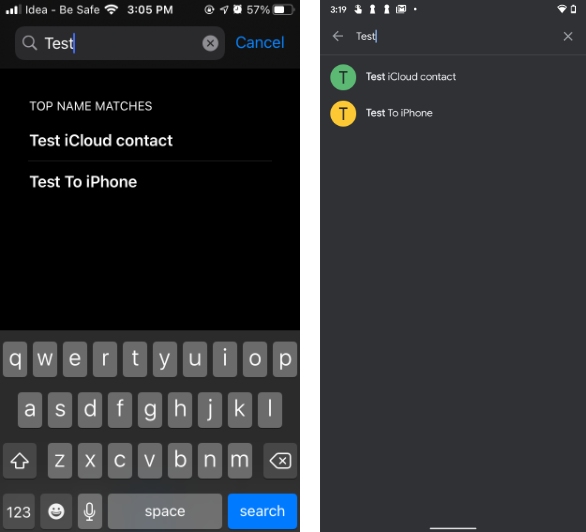
Same way, when I create a new contact on my iPhone, it automatically shows up in my Google Contacts, and eventually on other Android devices linked to it. I don’t think syncing your Android contacts to iPhone would be more seamless than this.
However, these contacts won’t show up on your other iOS devices since the contacts aren’t synced to your iCloud account. To do so, you can read the methods mentioned below.
How To Copy Contacts To iPhone Using VCF (vCard)?
Now, if you’re planning to switch to an iPhone permanently, then you will need your contacts synced to the iCloud account. So, here is the good old method of using a VCF file to send Android contacts to iPhone. You can follow the steps mentioned below:
- On your stock Android phone, open the Contacts app.
- Tap the hamburger menu button in the top-left corner > tap on Settings.

- Now, scroll down and tap on the Export button.
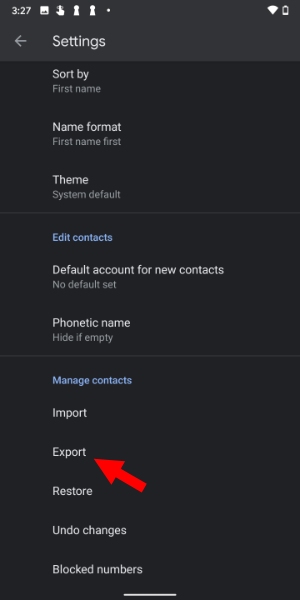
- Next, type the name of the VCF file which will be saved to the Downloads folder.

Now, you can mail this VCF file to your iPhone. To add contacts, simply open the file, and your iPhone will copy all the contacts automatically.
Here, we have detailed the method using the Contacts app on the stock Android. But if you’re using the contacts app from your device maker such as Samsung, Xiaomi, etc., you can create a VCF file from the respective app to transfer contacts to the new iPhone.
How to transfer data from Android to iPhone via Move to iOS app?
If syncing data over the cloud isn’t your thing, then there is another way of transferring contacts from Android to iPhone. Out of the three apps Apple has made for Android devices, one of them is called Move to iOS and precisely does what its name says.
Move to iOS backs up the contacts, messages, bookmarks, calendars, camera photos and videos, mail accounts from your Android device to an iPhone or iPad locally over WiFi.

To get started, you can download the app from Google Play. Then the backup process needs to be done while you’re setting up the iPhone. When you’re on the Apps & Data screen, tap on Move Data from Android option and follow the steps.
However, that’s also the downside of the app. If your iPhone is already setup, then you’ll have to erase the device to copy data from Android. Depending on the amount of data, the Android to iPhone transfer process might take more or less time for different users.
Here, if the Move to iOS app isn’t working, you need to make sure that both the devices are charging for the Move to iOS app to work smoothly. During the transfer process, you manually select/deselect what data you need to move. For example, you can choose to shift contacts alone.
So, these were the ways using which you can import contacts to iPhone from your Android device or Google account. Here, again, I’d suggest the easiest and the most efficient way is to go for Gmail sync. That way, you can keep all your contacts synced across Android and iOS devices without the platform being a hurdle.
What do you think of Apple’s cross-platform compatibility efforts? If you have anything else to add, feel free to drop your thought?
The post How To Transfer Contacts From Android To iPhone In Real-Time? appeared first on Fossbytes.
Technology
Microsoft’s Surface Phone has a feature that many Android handsets lack
- After revealing the Surface Duo price and release date, Microsoft made a surprising announcement regarding its new Android endeavor.
- The Surface Duo will receive three years of Android updates, which matches Google’s guarantee for the Pixel but also Samsung’s recent decision to support some of its Androids for three years.
- Not many Android handset makers are willing to provide steady Android updates to their devices, which remains one of Google’s main Android weaknesses.
Microsoft earlier this week revealed the price and release date of its first Android handset ever, the Surface Duo that was unveiled almost a year ago. The device is a different take on the foldable phone concept, as Microsoft is using two standalone displays connected by a 360-degree hinge to deliver a smartphone with a larger overall display than traditional smartphones. The handset is hardly perfect, featuring last year’s best mobile chip but lacking the allure of other Androids. It’s got no 5G support and no NFC, and the single camera might not measure up to your mobile photography needs. It’s also expensive, starting at $1,399, compared to other 2020 flagships. But the Surface Duo does target a specific set of consumers. Buyers who need both Android and Windows in their lives might benefit from this particular contraption, especially if Microsoft will be able to make Windows shine on an Android device.
What makes the Surface Duo interesting is a detail that’s just come to light, a feature that many of the traditional Android handset makers aren’t willing to guarantee: Updates.
Microsoft told The Verge that “Surface Duo will be supported with OS and security updates for three years.” That’s an incredible thing to advertise for a company that’s making its first-ever Android phone. And for a company that doesn’t control the Android release cycle.
It’s usually Google that would reveal details about guaranteed Android updates for its Pixel phones, not the other handset makers that use the operating system on their phones. And Google was never able to match Apple when it comes to software support for mobile devices. One of the best things about the iPhone is that it’s made to last longer than any of its counterparts, both when it comes to performance and updates.
In a surprising move a few weeks ago, Samsung promised to support three generations of Android updates on certain Galaxy phones, a first for the company. The guarantee applies to the S, Note, and Z series, but it was still great news to buyers.
Samsung hasn’t been at the forefront of Android updates, not even after Google made it easier for Android handset vendors to access new versions quicker and release their own updates in a more timely manner. As before, Android updates aren’t solely in the hands of Google or its partners. Carriers also have a say in the whole thing, which can further delay releases.
The fact that Microsoft is willing to go down the same route as Google and Samsung is certainly refreshing, and could motivate others to follow suit. Of course, when you only sell a single phone that targets a particular niche of buyers, it’s easy to guarantee updates. But Microsoft’s commitment shouldn’t go unnoticed. With three years of updates, that $1,399 price tag might be easier to swallow. The question is, how well will a Snapdragon 855-powered Android device behave on Android 14 three years from now.
Technology
Anti-5G group crowdfunds £100,000 to hire superstar lawyer to fight roll-out
Renowned barrister Michael Mansfield QC is to take on the British government over its roll-out of 5G technology.
Action group Action Against 5G has so far crowdfunded an astonishing £105,000 to pay the legal brain to represent them.
They say UK scientists have failed to take enough notice of the potential health risks and public concern related to the fifth generation technology standard for phone networks.
Mr Mansfield, head of Nexus Chambers, has now sent a letter before action to the government and the next step is to apply to the High Court to have the case heard in full.
The group hopes the action will force a judicial review.
Having Mr Mansfield take on the case is a coup for the group as he has been involved in a number of high profile cases including the fire at Grenfell Tower, the Hillsborough football disaster, the murder of black teen Stephen Lawrence and the Lockerbie bombing.
Action Against 5G says on its Crowd Justice site that the government has failed to take into account evidence that radiofrequency radiation from masts and wireless devices does in fact impact health.
It wants a full and independent examination of the risks and believes the public should have a say in the roll-out.
It says that instead, ‘the government continues to adopt guidelines which the independent scientific research shows is unsafe for humans, animals, and the environment.’
And the group believes that ‘the consequence of inaction could be serious and irreversible damage.’
It went on: ‘We are individuals supported by many from all walks of life including doctors, scientists and engineers.
‘We have joined forces with a strong team of lawyers headed by Michael Mansfield QC.
‘Michael Mansfield has represented the families in the Grenfell Tower, Lockerbie, Hillsborough, Ballymurphy Massacre and Stephen Lawrence cases.
‘Before 5G can be imposed on us all with potentially devastating effects on our health and the environment, we need proper independent reviews of all research into the health risks, and reviews of the science concerning the potential environmental impact.’
The group wants environmental risk assessments carried out to prove the technology is safe for humans and wildlife and ‘an informed debate on the consequences of imposing 5G technology on humans and the environment.’
It added: ‘People have a right to be informed about the risks and what they will be exposed to.
‘There should also be a choice to opt out, particularly for children and other vulnerable groups.
‘We are not against the progression of technology but we do not consent to the imposition of technology at the risk of harming our health and potentially all biological life.
‘Nothing other than a legal challenge will force a government to take notice; this is the only way to ensure the government engages with the issue.’
5G delivers faster and better mobile broadband. In 2017, the amount of mobile data used increased by 40%, with the public’s thirst for information on the go showing no sign of abating.
Ofcom regulates the use of radio frequencies by mobile networks and tests electro magnetic fields (EMF) levels near to mobile phone base stations.
It was recently forced to put out a statement debunking conspiracy theories that 5G was responsible for the Coronavirus pandemic.
Guideline levels of exposure are set by the International Commission on Non-Ionizing Radiation Protection (ICNIRP) and underpin health protection levels in the UK and Europe.
Public Health England’s website states: ‘It is possible that there may be a small increase in overall exposure to radio waves when 5G is added to an existing network or in a new area.
‘However, the overall exposure is expected to remain low relative to guidelines and, as such, there should be no consequences for public health.
‘PHE is committed to monitoring the evidence applicable to this and other radio technologies, and to revising its advice, should that be necessary.’
EE has said there are no proven health effects of the technology.
-
 Business4 weeks ago
Business4 weeks agoBernice King, Ava DuVernay reflect on the legacy of John Lewis
-
World News3 weeks ago
Heavy rain threatens flood-weary Japan, Korean Peninsula
-
 Technology3 weeks ago
Technology3 weeks agoEverything New On Netflix This Weekend: July 25, 2020
-
Finance3 months ago
Will Equal Weighted Index Funds Outperform Their Benchmark Indexes?
-
Marketing Strategies7 months ago
Top 20 Workers’ Compensation Law Blogs & Websites To Follow in 2020
-
 World News7 months ago
World News7 months agoThe West Blames the Wuhan Coronavirus on China’s Love of Eating Wild Animals. The Truth Is More Complex
-
Economy10 months ago
Newsletter: Jobs, Consumers and Wages
-
 Finance8 months ago
Finance8 months ago$95 Grocery Budget + Weekly Menu Plan for 8

